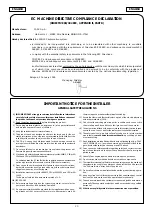
11
TROUBLE SHOOTING
- Add shim behind top guide attachment to wall.
- Mounting brackets to low:
a. Raise brackets, or
B. Cut track from bottom. (Door will hang in opening).
Assembly
MUST BE
parallel with header.
e. Repeat procedure for other end of curtain.
d. Retighten saddle clamp bolts.
Figure 1 - Page 3.
setting has been obtained. See dimension “J” -
c. Push curtain assembly toward header until correct
b. Loosen saddle clamp bolts on one end.
a. Adjustment must be made with door fully open.
To adjust mounting position:
over guide leads... - Door assembly is mounted too far from opening.
6. Door operates stiffly or curtain rattles - Guides are too long.
5. Door telescopes or rolls up unevenly... - Mounting brackets are not level, or are too low.
- To straighten door curtain:
a. Adjust mounting brackets to the correct position
(Figure 1).
b. While positively retaining door curtain to prevent
unwinding of spring, remove guides from jambs.
c. Lower curtain to floor, and carefully raise, to square
the curtain back up on the barrel. (Do Not remove
positive hold on curtain until guides are back in
place). Repeat as necessary.
d. Replace guides and bottom bar stops.
- Guides are not plumb.
- Spring tension too high. See Page 7 for tension
Adjustment procedures.
floor evenly... - Mounting brackets are not level.
4. Bottom weatherseal does not contact - Floor is not level.
both sides).
- Mounting brackets too low. Check Figure 1 for
proper location.
guide. Check Figure 6 for required clearance on
- Insufficient clearance between curtain and inside of
- Guides may be damaged.
must be made with door fully closed).
- Guide leads are improperly adjusted. (Adjustment
- Guides are not plumb.
- Door assembly incorrect distance from wall.
- Curtain assembly is not parallel to opening.
3. Door is hard to operate... - Mounting brackets are not level.
2. Door is easy to open, but hard to close... - Excessive spring tension.
1. Door is easy to close, but hard to open... - Insufficient spring tension.
SYMPTOM
POSSIBLE CAUSE































